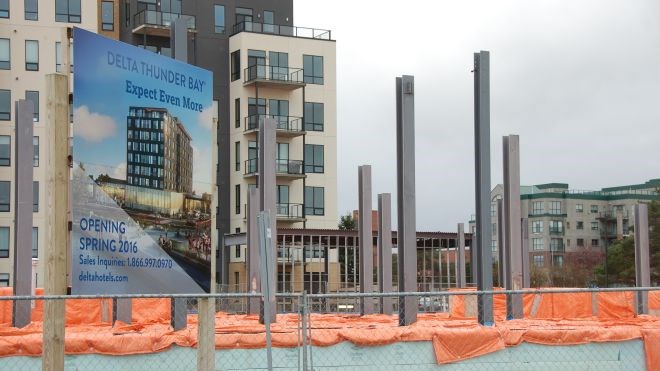A landmark building in Thunder Bay’s north end might realize a new life as a boutique hotel.
The former Thunder Bay District Courthouse on Camelot Street in the city’s north end was sold recently to a Toronto developer through his numbered company.
“He’s a very quiet gentleman, very methodical, who’s figuring it all out behind the scenes,” said Tourism Thunder Bay manager Paul Pepe, who’s acting as the developer’s spokesman. “He doesn’t want to tip his hands too much to the public.”
The courthouse, built in 1924, closed when the consolidated courthouse in the city’s south end was opened in 2014.
Though listed by Infrastructure Ontario at $570,000, the building was sold for a reported $500,000.
Pepe said he walked through the building with the developer and came away impressed with the condition inside.
The building is structurally sound but needs obvious renovations and retrofitting for the transition to a hotel. The interior is trimmed in oak and the terrazzo floors throughout the building remain in “mint shape,” said Pepe. There are working elevators and basement jail cells.
Pepe imagines the former main courtroom being an “awesome event space,” but that’s up to the new owner. Some of the judges’ offices come with private two-piece bathrooms.
Situated on a hillside, the building features large east-facing windows overlooking the harbour, offering plenty of natural light.
The developer hasn’t yet shared his vision for the structure, its final room count, or how the space will be used. Pepe speculates that the property has potential space for 45 guest rooms.
Pepe would not say if there are plans to bring in a brand-name hotel for the site. That’s up to the developer. The tentative opening is mid-2018.
As a provincially designated heritage building, there are restrictions in place to protect key architecture and design elements when it comes to refurbishments. Those conditions turned off other potential buyers, said Pepe.
But he thinks the building could be offer something unique to Thunder Bay’s hotel scene that’s within walking distance of the Waterfront District.
But just when Pepe thinks Thunder Bay has reached critical mass in its hotel building boom – the latest addition being last fall’s opening of a Hampton Inn and Suites near the airport – the accommodation stats tell him otherwise.
Hotel performance in 2016 was 70 per cent occupancy. For the first four months of 2017, it was 63 per cent, up from 59 per cent during the same time period in 2016.
Corporate events, life sciences, and education-related conferences, and winter sporting events, such as the Under-16 Canadian Alpine Championships hosted last February, continue to drive traffic to the northwestern Ontario city.
“We’re also a regional hub for a lot of the Indigenous communities,” said Pepe. “They’re here for education, business and health care, and the tribal councils do a lot of business in the city.”
The latest addition to the city’s hotel stable is current construction of a much-anticipated Delta-Marriott hotel at Prince Arthur’s Landing on Thunder Bay’s refurbished waterfront.
Helmed by Winnipeg’s ReSolve Group, the 150-guest room hotel is slated for a ribbon-cutting in August or September 2018.
In late June, elevator shafts extending vertically to the fifth floor and crossbeams for a 5,300-square-foot ball room were being installed. When finished, the hotel will offer 6,000 square feet of meeting space.
Pepe said the hotel’s opening meshes nicely with the city hosting the Canadian Chamber of Commerce’s annual general meeting in late September next year.
The conference will be staged at the Valhalla Inn near the airport but all area hotels should see a delegate spillover.
Conventions are a huge contributor to Thunder Bay’s tourism sector, which has a $170-million impact on the local economy, attracts more than a half-million visitors annually, and supports 3,000 full-time jobs.
The much-debated and studied Event and Convention Centre – a combination hockey arena and convention space for the Waterfront District – remains in park mode pending a change in federal and provincial policy on funding those types of venues.
First proposed in 2010, it was being looked upon as a catalyst to further heighten the city’s national profile among convention and sport tourism organizers.
Undaunted, Pepe’s tourism department has been innovative to draw more meetings to town through a Convention Incentive and Rebate Program.
Tourism Thunder Bay offers a rebate program for organizations, associations or businesses bringing a new event to town or staging one that’s not been back for five years or more.
Drawing from a special pool of $15,000, the department reviews each application and offers funding for events with a minimum two-night stay, a minimum of 50 delegates, with $5 per guest/delegate up to a maximum of $1,500.
“It’s something we rolled out last year,” said Pepe. “We’re seeing national leads and really unique business and convention leads that we weren’t seeing before. “
He suggested the funding can be applied to assist with things like shuttle transportation, speakers and coffee breaks. About seven or eight clients have taken advantage of it this year.
To grow that pool, Pepe said he’s working with the city and local hoteliers to implement a hotel tax in 2018, following a provincial budget move allowing municipalities to levy the tax.
“We want to grow that (incentive) pot in a big way and invest in product development and more aggressive sport and convention attraction bidding and hosting. We see a hotel levy as a really critical part of that.”




